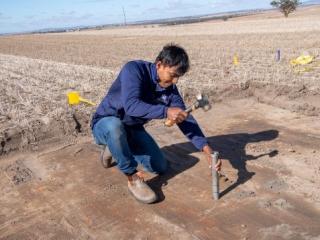Transforming soil for enhanced crop vitality
Project name
Re-engineering soils to improve the access of crop root systems to water and nutrients stored in the subsoil
GRDC code
DAW1902-003RTX
Crop yield breakthroughs at the forefront
The Department of Primary Industries (DPIRD) with support from the Grains Research and Development Corporation (GRDC), is currently entering the concluding phase of a comprehensive 5-year project.
The overarching goal is to re-define the water-limited upper limit for crop grain yield in rain-fed dryland agricultural environments.
This is being accomplished through a strategic approach, addressing multiple soil constraints, and ultimately leading to a substantial boost in grain yields.
Commencing in 2019, DPIRD researchers have been actively engaged in reengineering soil profiles on a considerable scale.
The focus extends to 80cm depth, encompassing diverse constraints, such as compaction, water repellence, acidity, alkalinity, sodicity and water holding capacity associated with both sandy and clay soils.
The central objective is to establish new benchmarks in yield for various crops, especially wheat, barley and canola.
This is achieved through the enhancement of crop root access to deeper soil, ensuring improved availability of moisture and essential nutrients.
Revitalising WA’s arable land
Spanning over 12 million hectares of arable land in the south-west of Western Australia, the project targets a range of soil types, including deep sand, texture-contrast soil (duplex), and heavy sodic and boron-toxic soil.
This region often grapples with subsoil compaction, subsoil acidity, sodicity, elemental toxicity (e.g. aluminium and boron) and water repellence.
Experiments at a glance
Researchers have established a total of 11 soil profile re-engineering experimental sites at Bonnie Rock, Salmon Gums, Holt Rock, Carnamah, Toolbrunup, Bolgart, Northampton, Meckering, York, Tarin Rock, and Kojaneerup.
In this project, the team has also conducted a series of 80-centimetre-deep soil column experiments in a controlled environment to determine optimum soil packing density, rates of soil amelioration and inorganic nutrients to improve the learnings from the field experiments.
These sites are equipped with advanced soil moisture probes allowing real-time tracking of soil water, and root architecture monitoring devices to observe crop root development.
Significant outcomes have been achieved at specific trial sites, showcasing notable improvements in wheat, barley and canola yields compared to the average paddock yields. Incorporating clay, lime, and nutrient additions have proven successful in these cases.
Sandy soil
For example, sites prepared on sandplain country at Bolgart and Northampton were excavated to a depth of 80-centimetres, and clay was incorporated to improve water holding capacity. Lime, compost, and inorganic nutrients were also applied.
At the Northampton site in 2021, the wheat yield in the best treatment was 3.3 tonnes per hectare, well above the paddock average of 0.97t/ha. In 2022, the wheat crop yielded 3.8t/ha which is more than double the paddock average of 1.5t/ha.
In 2021 at the Bolgart site, the wheat crop had poor establishment and did not respond well. While in the 2022 season, the canola crop yielded 2.8t/ha compared to the paddock average of only 0.6t/ha.
Texture contrast soil
Loamy duplex soils were examined in four field experiments conducted near Meckering, York, Tarin Rock, and Kojaneerup.
These sites, excavated to a depth of 80cm, underwent various amelioration treatments.
At the Meckering location during the 2021 season, the canola crop exhibited a remarkable yield of 3.1t/ha, compared to the paddock average of 1.4t/ha.
Subsequently, in the 2022 season, the barley crop yielded 6.3t/ha, compared to the paddock average of 3.5t/ha.
Moving east of York, the wheat crop at the trial site yielded 5.1t/ha in 2021, outperforming the paddock average of 3.5t/ha.
In the following year, the canola crop at the same site achieved a yield of 3.7t/ha, significantly exceeding the paddock average of 3.0t/ha, even in a record-setting season.
At the Tarin Rock trial site in 2021, the barley crop yielded 4.1t/ha, a notable increase from the paddock average of 1.4t/ha.
However, in 2022, the canola crop experienced severe hail damage just before harvest.
Looking to the future
The project team is currently working on the data from the 2023 season, which was extremely dry, especially the latter half of the season.
Beyond immediate yield gains, the project will redefine the upper limits of crop yield potential in water-limited, dryland agricultural environments in Western Australia.
The overarching objective for researchers, is to develop enduring and profitable strategies for growers to be able to effectively manage soil constraints.
Funding partners / project collaborators
Grains Research and Development Cooperation
Contact
Dr Gaus Azam
DPIRD Principal Research Scientist
E: Gaus.Azam@dpird.wa.gov.au
P: 08 9690 2159

